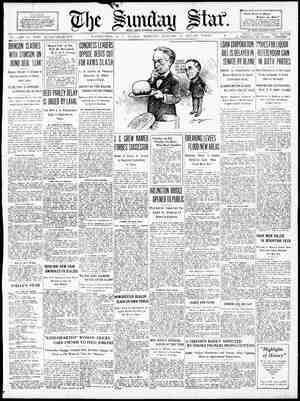Evening Star Newspaper, January 17, 1932, Page 67
You have reached the hourly page view limit. Unlock higher limit to our entire archive!
Subscribers enjoy higher page view limit, downloads, and exclusive features.
Features ArtNotes Magasine WASHINGTON, D. "C., [ JANUARNY 17 1932 ot Bridge 20 S e e PART Saving” a Language by Movies Film Now Being Finished in National Capital, Scheduled for Initial Exhibition in February, Will Be Permanent Record of Indians’ System of Communication by Signs—Greatest Intertribal Meeting of Chiefs Ever Recorded by W hite Men Is Part of Project. The motion picture camera is here shown as it stood ready to undertake one of the strangest jobs in its career, the photographing of a language. In front of the camera are seen some of the Indian chiefs who met in a special council at Browning, Mont., to provide a permanent photographic record of their significant hand-wavings. By Ira L. Smith LOQUENT hands are moving to save a language which has flour- ished in America during 10 cen- turies from coming to a dull and rather pathetic end. The hands are those of patriarchal mer who knew the Western prairies 60 years ago; the language is that soundless array of signs invented by Indians in the long ago. A timely call has brought the motion picture camera, sole means by which the “talk without a tongue” can be recorded, to block the way which leads to extinc- tion. Linked with use of the camera in this unprecedented effort are the hand- waving abilities of a famous general and 14 Indian chiefs. Reels of celluloid upon which sign speech of the 15 venerables has been photographed are now in final stages of production in Washington under the supervision of the Federal Government. The finishing touches are being applied in the motion picture studio of the De- partment of Agriculture, located in a low brick building, secluded in C street 'zt official showing of the language- preserving pictures is scheduled to take place in Washington in February. It is possible the initial exhibition will be given at the White House. And a copy of the film will be placed in the archives of the Smithsonian Institution as an his- torical record. A PORTION of the unique record will consist of film showing the silent proceedings of a gathering of 14 Indian chiefs, held a few months ago, for the special purpose of perpetuating the man- ual signs. The meeting, stated by authori- ties to have been the greatest inter- tribal conclave since white men opened their annals in America, took place at Browning, Mont. Maj. Gen. Hugh L. Scott, who was designated by Congress to take charge of the project, is coming to Washington within a short time to complete the movie record by compiling a “film dic- ionary,” which will show approximately 1,300 signs which have found their way into the gesture-talk of the Indians. This phase of the work is now one-third finished. When Gen. Scott and the Indian chiefs met at Browning, they immediate- ly organized a “Great Council of North- western Indians,” with each of the chiefs representing an individual tribe. Chiefs who participated, ranging from 55 to 82 years in age, are officially listed by the following avowedly colorful names and tribal affiliations. Mountain Chiel, a Blackfoot of Mon- tana; Washakie, a Shoshoni of Wyom- ing; Tom White Horse, an Arapahoe of Wyoming; Bitter Root Jim, a Flathead of Montana; Bird Rattler, a Blood of Montana; Deer Nose, a Crow of Mon- tana; Strange Cwl, a Cheyenne of Mon- tana; James Eagle, an Arikara of North Dakota; Foolish Woman, a Mandan of North Dakota; Iron Whip, a Yanktonai Sioux of Montana; Drags Wolf, a Lower Grosventre of North Dakota; Rides Black Horse, an Assiniboin of Montana; Assini- boin Boy, an Upper Grosventre of Mon- tana, and Fine Young Man, a Sarcee of Canada. ” URING the council the chiefs sat around a fire built in a ring of stones at the center of the tepee. Gen. Scott occupied the place of honor, The camera, a contrivance that would have sent the chiefs’ ancestors shouting for medicine men or reaching for spears; was placed at the entrance of the tepee in a position which permitted its lens to be trained upon all sections of the coun- cil circle. Preliminary plans, drafted by Gen. Scott with all the knowledge gained by campaigning in the Western States dur- ing many years, were closely followed, These plans called for each chief tem= porarily so forsake the language of his tribe and to use the intertribal sign lan< guage exclusively. This proceduire was contrived to produce definite and lasting evidence that members of all the tribes which had engaged in buffalo hunting could use the signs with facility and un- derstanding. When hunting buffalo, Indians often moved far from their home country and came upon members of tribes who spoke a language completely different fromy their own. In need of a means of comm munication, they resorted to simple signs
